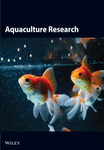Transplantation and Culture of the Yesso Scallop Mizuhopecten ( = Patinopecten) yessoensis in Southeast Sea of Korea
Abstract
This study aimed to assess the survival and growth rates of Yesso scallop Mizuhopecten ( = Patinopecten) yessoensis spat transplanted from the East Sea and cultured in both inner and outer areas of Goseong Bay, Korea, using idle Bay scallop (Argopecten irradians) aquaculture facilities during the off-season (November–June). Additionally, economic feasibility of this cross-cultivation approach was evaluated. Yesso scallop spat with a mean shell length of 17 mm were stocked in lantern nets in both inner and outer areas of Goseong Bay in October 2020 and monitored monthly until June 2021. Environmental parameters, including surface seawater temperature (SST), dissolved oxygen (DO), and chlorophyll-a concentration, were continuously recorded. High survival rates (92%–100%) were observed at both sites, and scallops reached marketable sizes (shell length 62.0–65.0 mm; total weight 25.6–28.5 g) by June. The final shell length and total weight were 65.0 mm and 28.5 g in the inner bay, and 62.0 mm and 25.6 g in the outer bay, respectively; although these differences were statistically significant, the overall size and weight achieved in both areas were similar and commercially acceptable. Economic analysis demonstrated a return on sales (ROS) of 49.8% and a benefit–cost ratio (BCR) of 2.0 for Yesso scallop cross-cultivation, exceeding those of conventional Bay scallop monoculture. These findings indicate that utilizing existing aquaculture infrastructure for Yesso scallop production during the Bay scallop off-season is both biologically viable and economically advantageous, providing a practical strategy for optimizing facility use and revitalizing Yesso scallop aquaculture in Korea.
1. Introduction
Scallops are highly valued seafood worldwide due to their delicate flavor, high-quality protein, and rich nutritional content, making them popular among health-conscious consumers and a staple in diverse cuisines [1]. Global demand for scallops has remained strong, with annual consumption exceeding 2 million metric tons over the past 5 years, primarily supplied by aquaculture in East Asia, including China, Japan, and Korea [1]. The market significance of scallops is further underscored by their economic value, global scallop farming was worth approximately USD 9.27 billion in 2023 and is projected to continue growing, driven by consumer preference for sustainable, nutritious seafood and the premium prices that scallops command in both domestic and export markets [2].
In Korea, three scallop species, such as Yesso scallop (Mizuhopecten yessoensis), Bay scallop (Argopecten irradians), and Farreri’s scallop (Azumapecten farreri), are used commercially in the aquaculture industry [3–5]. Yesso scallop is a cold-water species that is primarily cultured on the east coast of Korea because of the suitable environmental conditions, such as cool water temperatures and wave patterns, which aligns with its optimal growth requirements [3]. Yesso scallop production on the east coast of Korea peaked at 1798 tons in 1996 but declined sharply to 300 tons in 2018 due to mass mortality events [6]. Despite ongoing cultivation, domestic production remains insufficient, necessitating its imports from China and Japan [4].
Bay scallop is a temperature-sensitive species that is native to the Atlantic coast of North America and was introduced to China in 1982 and then to Korea in 1996 for aquaculture [7]. Bay scallops can be harvested approximately 6 months after spat deployment, and they grow three times faster than Yesso scallops and Farreri’s scallops [6]. This rapid growth has led to the expansion of Bay scallop aquaculture along the southern coast of Korea since the 2000s. Bay scallops experienced a rapid industrialization in the semi-closed bays located in Tongyeong and Goseong on the southern coast, and the production increased rapidly from 193 tons in 2013–5000 tons in 2018 [6]. The cultivation cycle of Bay scallops typically runs from April to October, leaving the aquaculture facilities idle from November to June [6].
Yesso scallops have a wide temperature tolerance range, from −2 to 26°C [8]. Optimal growth occurs between 4 and 8°C [9], and rapid daily shell increment has been observed between 8 and 16°C [10]. Interestingly, the water temperatures during the idle period of Bay scallop aquaculture facilities in Goseong Bay on the southern coast of Korea range from 5.8 – 24°C, which is potentially suitable for Yesso scallop cultivation. Moreover, the chlorophyll-a concentration in Goseong Bay is significantly higher (0.7–8.7 μg/L) than that in the East Sea (0.4–1.8 μg/L) [11], suggesting the availability of more abundant food resources for filter-feeding scallops. Despite these promising conditions, there is a lack of research on the feasibility of cultivating Yesso scallops in the southeast sea of Korea, particularly during the idle period of Bay scallop aquaculture. This knowledge gap limits diversification and the efficient use of existing aquaculture infrastructure.
Therefore, this study aimed to (1) assess the survival and growth rates of Yesso scallop spats transplanted from the East Sea and cultured in Goseong Bay using idle Bay scallop aquaculture facilities during the off-season (November–June), and (2) evaluate the economic feasibility of this cross-cultivation strategy by estimating profitability and cost-effectiveness. By addressing these aims, this research provides a practical basis for the efficient use of existing aquaculture infrastructure and contributes to the revitalization of Yesso scallop production in Korea.
2. Materials and Methods
2.1. Study Area and Environmental Parameters
Goseong Bay is one of the major scallop farming areas located off the southern coast of Korea, and it encompasses a 2100 ha surface area with a mean depth of 7 m [12, 13]. The inner and outer bay areas differed in their hydrographic characteristics, with the inner bay having shallower depths and reduced water exchange than the outer bay. The sediment composition of the two sites, which consists primarily of silt and sand, is similar. Bay scallops (A. irradians) are cultured in this bay from June to October using lantern nets.
The surface seawater temperature (SST) and dissolved oxygen (DO) in the inner and outer bays of the scallop farms were recorded using a HOBO Dissolved Oxygen Logger (U26-001; Onset Computer, USA). In addition, the chlorophyll-a level in the water column was measured using a chlorophyll fluorescence meter (Infinity-CLW; JFE Advantech Co. Ltd., Japan). Environmental data were continuously recorded at hourly intervals from December 2020 to June 2021.
2.2. Scallop Transplant
Yesso scallop (M. yessoensis) spats were purchased from Sokcho (38°13′00″ N, 128°36′30″ E), Gangwon Province, on the east coast of Korea in October 2020. The spat used in this study were produced from the artificial hatchery. The spats were then transported to Goseong Bay on the southern coast (Figure 1). Upon arrival, they were placed in lantern nets and acclimatized to the bay environment for 1 day.
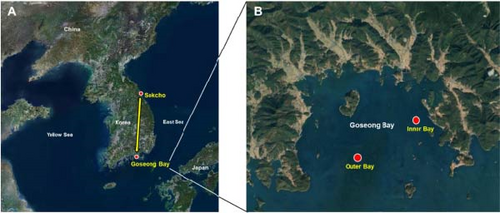
In October 2020, Yesso scallop spats with a mean shell length of 1.7 cm were transplanted into lantern nets suspended at a depth of 2–4.5 m in both the outer (34°54′18″ N, 128°13′39″ E) and inner (34°55′21″ N, 128°15′11″ E) areas of Goseong Bay (Figure 1). The spats were stocked in 15-tier cages with a mesh diameter of 50 cm, at a density of 30 individuals per tier. This density aligns with suspended culture practices for Yesso scallops on the east coast of Korea, and has been shown to balance growth and survival without causing overcrowding [14]. A total of 50,000 spats were stocked in both outer and inner bays, respectively.
2.3. Survival Analysis
Monthly mortality assessments were conducted from October 2020 to June 2021 using a destructive sampling approach. Each month, one complete lantern net containing 15 tiers (~450 scallops) was retrieved from both the inner and outer bay sites and transported to the laboratory for analysis. Dead scallops were identified by their open shell valves and counted to determine monthly mortality rates. Once assessed, these sampled scallops were not returned to the cultivation sites but were permanently removed from the experiment, representing an independent cross-sectional sampling rather than longitudinal tracking of the same individuals.
Survival analysis of scallops was performed using the Kaplan–Meier estimator [15] to compare survival probabilities over time between inner and outer bay sites. Monthly survival rates were calculated for each location based on observed mortality, and the cumulative survival probability was determined by multiplying the survival rates for each consecutive month.
2.4. Growth Measurements
To determine the shell length, the longest axis of the shell was measured to the nearest millimeter using a vernier caliper. From the same sampled nets, 150 scallops were randomly selected from the experimental population for shell length measurement. The total weight of these scallops was measured to the nearest gram using an electronic balance. Differences in shell length and total weight of scallops between inner and outer bays were analyzed using an independent Student’s t-test. All analyses were performed at α = 0.05 using SPSS version 25.0 (IBM, Armonk, NY, USA).
2.5. Specific Growth Rate (SGR)
2.6. Economic Analysis
2.6.1. Subjects of Analysis
In this study, the economic feasibility of cross-cultivation was analyzed by estimating costs and revenues based on a field survey of Bay scallop aquaculture farms in Tongyeong, Gyeongnam, on the southern coast, and the results of experimental Yesso scallop cultivation in Goseong, Gyeongnam. Due to their close geographical proximity, the two regions share a highly similar marine environment and aquaculture practices. The analysis was based on utilizing existing facilities and adopting the hanging culture method to cultivate purchased intermediate seedlings. Additionally, cost and revenue estimates were applied over a 1-year period within a 1 ha production scale [6]. In the case of fixed costs, the number of vessels required for small-scale operation (1 aquaculture management vessel and 1 barge without an engine) per 1 ha was considered, and as the aquaculture area increases, auxiliary rafts and transport vessels may be added, but they were excluded from the analysis. The facility cost includes initial investment costs (various ropes, floats, fishing gear, anchors, aquaculture management vessels, barges, vehicle purchases, fishing boat rental fees for anchor facilities, other miscellaneous items, and workshop facilities). The depreciation cost according to the durability is included in the annual production cost (variable cost) as an indirect production cost. In the case of variable costs, it includes facility management and maintenance costs, labor costs (permanent and temporary), indirect costs (seed purchase, transportation costs, general management costs, deductions and insurance premiums, and household expenses) and direct production costs (management costs).
2.6.2. Analysis Method
Subsequently, the benefit–cost ratio (BCR) analysis was conducted to determine economic feasibility by comparing investment costs and benefits. The BCR is calculated by dividing total revenues by total costs. A BCR greater than 1 (BCR > 1) indicates that the investment is economically viable. Single-year BCR analysis is a useful approach for making timely investment decisions in industries expected to experience rapid environmental changes [16]. The reason for conducting an economic evaluation through financial analysis in this analysis was to evaluate the sustainability of the investment or business and to find out whether the cross-farm is more economically advantageous than the existing scallop farm. The scientific validity verification was intended to be shown through the results of natural scientific experiments, and the economic evaluation was intended to be verified through financial modeling (rate of return, break-even point, depreciation, etc.) based on field data.
3. Results
3.1. Daily Changes in Water Temperature, DO, Chlorophyll-a Level
The SST in the inner and outer bays of the study area showed similar patterns of seasonal variation (Figure 2). In the inner bay, SST started at 8.6°C and decreased to its lowest point at 3.9°C in early January 2021. Thereafter, the SST steadily increased and reached a maximum of 23.3°C in June 2021. The outer bay displayed a comparable temperature trend: the lowest SST was 4.4°C in early January 2021, after which it consistently increased and peaked at 24.8°C in June 2021.
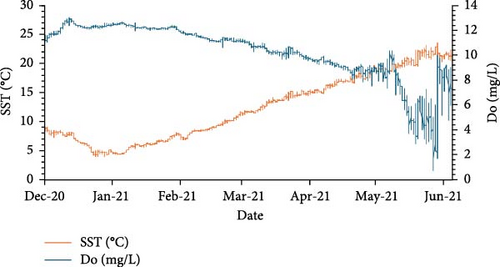

The DO levels in both the inner and outer bays remain relatively stable, ranging from 5.1 to 13.0 mg/L until May 2021 (Figure 2). However, significant differences were observed between the inner and outer bays after late May 2021. The DO levels in the inner bay began to decrease rapidly, dropping to a minimum of 0.7 mg/L in June and resulting in hypoxic conditions (DO < 3 mg/L). In contrast, the outer bay maintained more stable DO levels throughout the study period, with a minimum concentration of 7 mg/L.
The chlorophyll-a concentrations in Goseong Bay, which ranged from 0.05 to 5.6 µg/L with an average of 1 µg/L, remained relatively constant until mid-May (Figure 3). A significant increase in chlorophyll-a levels was observed after mid-May, and the maximum was 20 µg/L. This elevated concentration, with a high average of 8.7 µg/L, persisted until mid-June. This significant increase in chlorophyll-a levels from mid-May to mid-June indicates a notable increase in phytoplankton biomass, potentially affecting the trophic dynamics and food availability for filter-feeding organisms in the bay.
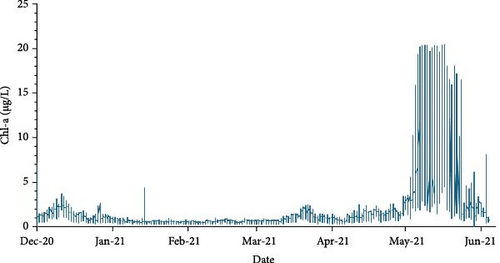
3.2. Scallop Viability
As shown in Figure 4, the survival probability for both groups remained high throughout the study period, with stepwise decreases corresponding to months with observed mortality events. The final cumulative survival probability at the end of the experiment was 71.8% in the inner bay and 80.6% in the outer bay, indicating that Yesso scallops in the outer bay exhibited a slightly higher overall survival rate compared to those in the inner bay.
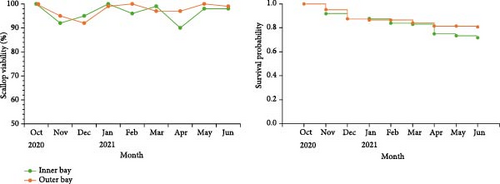
3.3. Monthly Variation in the Growth
Throughout the 9 months of growth in the Goseong bays, the shell length of the scallops increased from 16.8 ± 0.1 mm in October 2020 to 65.0 ± 7.0 mm in the inner bay and 62.0 ± 8.0 mm in the outer bay by June 2021 (Figure 5A). Statistical analysis revealed significant (p < 0.05) differences in shell length between sites at the end of the cultivation period, with the inner bay scallops being 3.0 mm larger than those in the outer bay. While outer bay scallops showed a transient advantage in February 2021, this pattern reversed by June 2021.
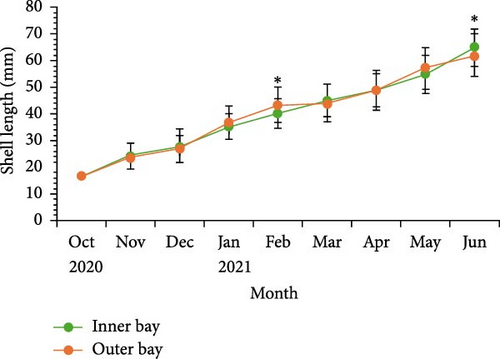

The total weight of the scallops could not be measured in October 2021. However, the total weight of the scallops increased from 1.7 ± 0.9 g (November 2020) to 28.5 ± 9.5 g (June 2021) in the inner bay, and from 1.6 ± 0.9 g (November 2020) to 25.6 ± 12.2 g (June 2021) in the outer bay by June 2021 (Figure 5B). Final mean scallop weight was 11.3% higher in the inner bay compared to the outer bay (p < 0.05), consistent with observed differences in shell length. These results indicate a substantial increase in shell length and total weight of scallops in both inner and outer bays during the cultivation period. The shell length and total weight of scallops recorded at the end of the study (6.2–6.5 cm in shell length and 25.6–28.5 g in total weight) are considered to be marketable size values [17].
3.4. SGR of Shell Length and Total Weight
The SGR of shell length in Yesso scallops exhibited similar seasonal patterns in both the inner and outer bays (Figure 6A). In the inner bay, SGR values ranged from 0.277% to 1.244% per day, while in the outer bay, they ranged from 0.046% to 1.175% per day. Both bays showed distinct peaks in SGR during November and January, with the highest values observed in November at both sites. Notably, the outer bay exhibited a relatively higher SGR than the inner bay in January, whereas in March, the SGR in the outer bay was lower compared to the inner bay.
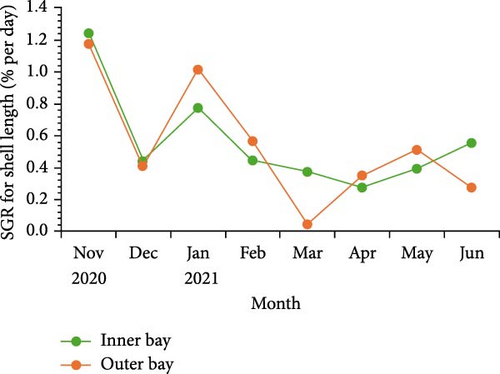
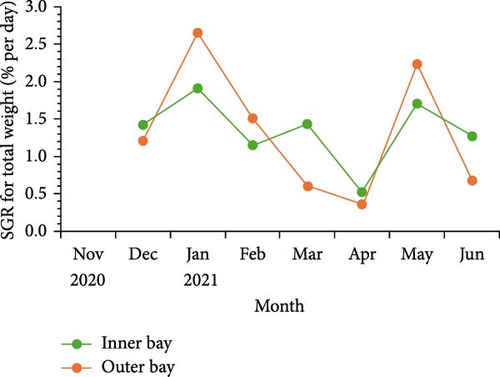
The SGR of total weight also showed similar seasonal patterns between the inner and outer bays (Figure 6B). In the inner bay, SGR values ranged from 0.523% to 1.902% per day, while in the outer bay, they ranged from 0.362% to 2.654% per day. Due to the absence of initial total weight measurements in October, SGR values for November were not available. Both bays exhibited SGR peaks in January, with the highest values recorded at 1.902% per day in the inner bay and 2.654% per day in the outer bay. Additional peaks were observed in March and May in the inner bay, and in May in the outer bay. Notably, the outer bay showed a relatively higher SGR than the inner bay in January, a lower SGR in March, and again a higher SGR in May.
These findings indicate that, although the overall seasonal trends in shell length and total weight SGR were similar between the two sites, the magnitude and timing of peak growth rates varied, with the outer bay generally supporting higher maximum growth, particularly during the winter and late spring.
3.5. Economic Analysis
Under the conditions specified in Table 1, the economic feasibility analysis of winter Yesso scallop cross-cultivation is shown in Table 2. The profitability analysis estimated total revenue at 529.5 million KRW and net income at 263.9 million KRW. The ROS for Bay scallops cultivation was 35.8%, higher than Yesso scallops. In particular, the ROS for winter Yesso scallop cross-cultivation was the highest at 49.8%. For Yesso scallops, the ROS was relatively lower than that of Bay scallops cultivation due to the higher proportion of direct costs, primarily resulting from the relatively high seedling costs.
| Parameters | Bay scallop | Yesso scallop |
|---|---|---|
| Longline number | 10 longlines/ha | 10 longlines/ha |
| Longline length | 100 m | 100 m |
| Lantem nets |
|
|
| Scallop density |
|
|
| Scallop viability | 83% | 95% |
| Cultivation period |
|
|
| Maketable size | 7 cm (45 g) | 8 cm (50 g) |
| Sales price | 4500 KWR/kg | 8000 KWR/kg |
| Production amount | 45,660 kg | 40,500 kg |
| Parameters | Bay scallop | Yesso scallop | Bay + Yesso |
|---|---|---|---|
| Total revenue | 205,470 | 324,000 | 529,470 |
| Total operating cost | 131,924 | 211,076 | 263,859 |
| Direct cost | 87,273 | 168,716 | 208,573 |
| Indirect cost | 44,651 | 42,360 | 55,286 |
| Net income | 73,546 | 112,925 | 263,859 |
| Return on sale ratio | 35.8 | 34.9 | 49.8 |
| Benefit–cost ratio | 1.6 | 1.5 | 2.0 |
The economic feasibility assessment using the BCR resulted in values exceeding 1 for all three methods, confirming their economic viability. Notably, the BCR for cross-cultivation was the highest, recorded at 2.0. This is a result not only of direct benefits (increased production) from cross-cultivation methods but also of a reduction in total operating costs through the utilization of idle facilities. These findings indicate that in the Gyeongnam region, generating new revenue through cross-cultivation is more effective than solely cultivating participant scallops in addition to the existing cultivation of Bay scallops.
4. Discussion
This study investigated the feasibility of using the idle Bay scallop aquaculture facilities in Goseong Bay, on the southeast coast of Korea, for winter cultivation of Yesso scallops (M. yessoensis). The rationale stems from the current low production of Yesso scallops in Korea [4–6], the seasonal nature of Bay scallop aquaculture (A. irradians), which makes the facilities vacant from November to June [6], and the potentially favorable conditions in Goseong Bay during this period. The water temperature in Goseong Bay during the Bay scallop off-season ranges from 5.8 to 24°C, which falls within the wide temperature tolerance range of Yesso scallop (−2 to 26°C; Ivin et al., [8]). Furthermore, the chlorophyll-a concentration in Goseong Bay (0.7–8.7 µg/L) is significantly higher than that in the East Sea (0.4–1.8 µg/L), suggesting better feeding conditions for scallops transplanted to the area. This study aimed to address this knowledge gap to help diversify aquaculture practices and maximize infrastructure use.
The results of this study demonstrate the successful transplantation and growth of Yesso scallops in Goseong Bay during the Bay scallop off-season. Kaplan–Meier survival analysis revealed high monthly survival rates (92%–100%) in both inner and outer bay locations throughout the cultivation period, with final cumulative survival probabilities of 71.8% in the inner bay and 80.6% in the outer bay after 9 months of culture. These high survival rates indicate that the environmental conditions in Goseong Bay were generally suitable for Yesso scallop cultivation, which is a critical finding for determining aquaculture feasibility.
The survival curves for the two sites exhibited similar patterns during the early cultivation period (October–March), but diverged notably from April onwards, with the inner bay showing a more pronounced decline. This difference coincided with significant changes in environmental parameters, particularly DO levels, which began to decrease rapidly in the inner bay after late May 2021, eventually reaching hypoxic conditions (0.7 mg/L) in June. In contrast, the outer bay maintained more stable DO levels throughout the study period (minimum 7 mg/L). Although the divergence in survival began before the most severe hypoxic conditions, the gradual reduction in DO likely contributed to the differences in survival patterns between sites. Despite these environmental challenges, it is remarkable that both locations maintained cumulative survival rates above 70%, which is considered commercially viable for scallop aquaculture. The 8.8% higher final survival rate in the outer bay suggests that areas with more stable oxygen conditions may be preferable for maximizing production efficiency in Yesso scallop cultivation. These findings provide valuable insights for site selection within Goseong Bay when implementing this cross-cultivation approach during the Bay scallop off-season. Substantial growth was observed in both inner and outer bays. Over the 9-month grow-out period, shell length increased significantly, reaching 65.0 ± 7.0 mm in the inner bays and 62.0 ± 8.0 mm in the outer bays by June 2021. Total weight also increased notably, from approximately 1.7 ± 0.9 g in November 2020 to 28.5 ± 9.5 g and 25.6 ± 12.2 g in the inner and outer bays, respectively, by June 2021. These growth rates suggest that Goseong Bay provides adequate nutritional resources and other environmental factors necessary for rapid Yesso scallop development. It is important to note that Yesso scallops grown in the East Sea can reach a size of 10 cm or more [3]. However, the Yesso scallops cultivated in Goseong Bay using the idle Bay scallop aquaculture facilities reached a size that is comparable to the marketable size of Bay scallops. Despite being smaller than their East Sea counterparts, the Goseong Bay-grown Yesso scallops attained a commercially viable size that is readily accepted by consumers. Furthermore, the shell length and total weight of scallops recorded at the end of the study (6.2–6.5 cm in shell length and 25.6–28.5 g in total weight) are considered to be marketable size values [17], indicating the potential for commercial viability.
In this study, we calculated the SGR of Yesso scallops cultured in Goseong Bay, providing a standardized metric for growth comparison that is not commonly reported in previous research on this species. Most existing studies have used absolute growth rate (AGR) as their primary metric. For example, on the east coast of Korea, the AGR for juvenile Yesso scallops has been reported at an average of 0.037 mm/day for shell length [1, 2], whereas in our study, scallops reared in Goseong Bay exhibited a higher range of 0.02–0.333 mm/day. Similarly, in China, the AGR for adult Yesso scallops based on total weight was reported at an average of 0.06 g/day [18], while our results from Goseong Bay showed a higher range of 0.02–0.3 g/day. These findings indicate that the growth rates achieved in Goseong Bay are comparable to or exceed those reported for other major cultivation regions. The use of SGR in our study allows for more direct and meaningful comparisons across different size classes and environmental conditions, highlighting the favorable growth environment provided by Goseong Bay. This suggests that utilizing idle aquaculture infrastructure in this region can effectively support rapid and commercially viable Yesso scallop production, with growth performance that meets or surpasses international benchmarks. The SST range in Goseong Bay (5.8–24°C) generally aligns well with the broad temperature tolerance of Yesso scallops (−2 to 26°C). Specifically, the lower temperatures observed during winter and spring are a suitable thermal environment for their survival and growth, even though they were not always within the optimal range of 4–8°C for optimal growth [3]. Furthermore, the temperatures between 8 and 16°C likely promoted high daily shell increments and contributed to the rapid growth in Yesso scallops. This indicates that the cumulative time of suitable temperature is very crucial in the growth of scallops. Additionally, the similar SST patterns observed in both locations suggest that temperature fluctuations did not significantly influence scallop performance in Goseong Bay during cooler months.
Despite the significant drop in DO levels observed in the inner bay after late May, which led to hypoxic conditions (DO < 3 mg/L) in June, scallop viability and growth did not appear to be negatively impacted compared to the outer bay, where DO levels remained above 7 mg/L. Although hypoxia is generally detrimental to shellfish, the Yesso scallops in this study showed an unexpected tolerance. The similar SST patterns observed in both locations suggest that temperature fluctuations did not significantly influence scallop performance. Further investigation is needed to explore the physiological mechanisms underlying this apparent tolerance to hypoxia and determine whether prolonged exposure to such conditions would have long-term effects on scallop health and productivity [5].
The elevated chlorophyll-a concentrations observed after mid-May likely contributed to enhanced feeding conditions in both bays. The higher chlorophyll-a concentrations in Goseong Bay (0.7–8.7 μg/L) compared to those in the East Sea (0.4–1.8 μg/L) likely provided superior feeding conditions that supported the growth of the scallop. This highlights the importance of phytoplankton availability as a critical resource for filter-feeding organisms like scallops [19, 20] and supports the idea that Goseong Bay offers a more productive environment for Yesso scallop cultivation compared to their native East Sea habitat. Hence, we observed a significant increase in Yesso scallop soft tissue growth after May, which coincides with the rising water temperatures and elevated chlorophyll-a concentrations in Goseong Bay. This observation aligns with the findings of Silina [10], who demonstrated the significant influence of water temperature on Yesso scallop shell growth rates. Although Silina [10] showed that excessively high temperatures (>18°C) could inhibit shell growth, the temperatures observed in Goseong Bay in May (typically ranging from 5.8 to 24°C) were likely within a more favorable range and promoted metabolic activity, which consequently resulted in soft tissue development. Moreover, the elevated chlorophyll-a levels after May, which indicate phytoplankton bloom, would have ensured an abundant food resource for the scallops, further promoting their rapid soft-tissue growth. Additionally, Silina [10] highlights the importance of food availability, noting that a phytoplankton biomass of 3.5–6.0 gm⁻³ provides high scallop growth rates. Although specific phytoplankton biomass data were not collected in the present study, the observed increase in chlorophyll a suggests that food resources were likely sufficient during this period, supporting the observed increase in soft tissue growth. Therefore, the combined effect of suitable temperatures and increased food availability likely contributed to the enhanced soft tissue growth of Yesso scallops in Goseong Bay after May.
The economic analysis results of this study demonstrate the high profitability of cross-cultivation of Yesso scallops in Goseong Bay. The ROS for winter Yesso scallop cross-cultivation was notably high at 49.8%, surpassing that of Bay scallop cultivation (35.8%). This high profitability can be attributed to several factors: the utilization of existing facilities, which reduced operating costs while creating a new revenue stream; the substantial growth rate of Yesso scallops, reaching a marketable size by the end of the study period; and the favorable environmental conditions in Goseong Bay, particularly the high chlorophyll-a concentrations, which likely promoted scallop growth. The BCR for cross-cultivation was the highest at 2.0, confirming its economic viability [21]. These results suggest that cross-cultivation using idle facilities is economically promising and could contribute to increasing domestic Yesso scallop production while diversifying income for aquaculture farmers. However, to generalize these economic analysis results, further research is needed, including long-term survival and growth rate data under various environmental conditions, as well as analysis of market demand and price fluctuations
While this study demonstrated the feasibility and profitability of Yesso scallop transplantation to Goseong Bay, we did not assess the potential ecological risks or the possibility of new recruits establishing in the region. Future research should investigate the long-term ecological impacts, including the potential for natural recruitment, genetic interactions, and disease transmission, to ensure the sustainability and safety of transplantation practices.
Overall, the results of this study indicate that the transplantation of Yesso scallops to inner and outer areas of Goseong Bay during the months from October to June is a viable way to grow the scallops to market size and increase profit. Economic analysis revealed high profitability for winter Yesso scallop cross-cultivation, with a ROS of 49.8% and a BCR of 2.0. This approach allows for more efficient use of existing aquaculture infrastructure and helps to potentially revitalize Yesso scallop production in Korea. Future research should investigate stock density optimization, evaluate the long-term impacts of hypoxic events, and explore the genetic adaptability of Yesso scallops to the Goseong Bay environment.
Conflicts of Interest
The authors declare no conflicts of interest.
Funding
This research was supported by the National Institute of Fisheries Science, funded by the Ministry of Oceans and Fisheries, Korea (Grant R2025027). This study was also supported by the Basic Science Research Program through the National Research Foundation of Korea (NRF), funded by the Ministry of Science and ICT (Grant RS-2021-NR061798).
Acknowledgments
This research was supported by the National Institute of Fisheries Science, funded by the Ministry of Oceans and Fisheries, Korea (Grant R2025027). This study was also supported by the Basic Science Research Program through the National Research Foundation of Korea (NRF), funded by the Ministry of Science and ICT (Grant RS-2021-NR061798).
Open Research
Data Availability Statement
The data that support the findings of this study are available from the corresponding author upon reasonable request.



